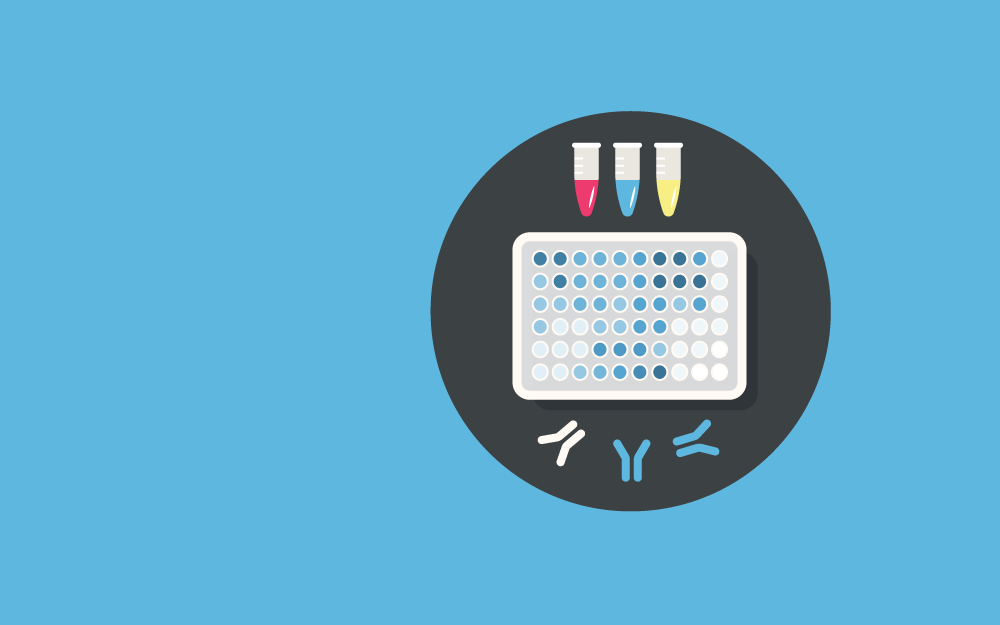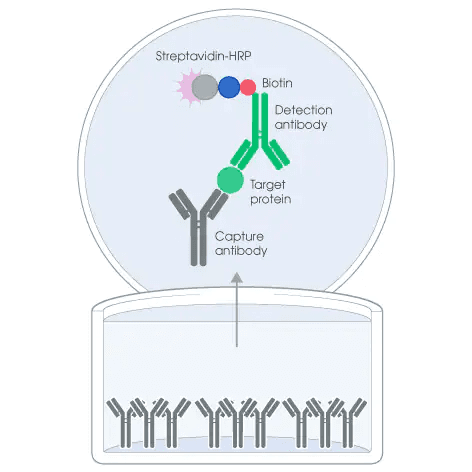

ELISA is short for enzyme-linked immunosorbent assay.[1] It’s an analytical biochemical assay used to study antibodies, glycoproteins, peptides, proteins, and hormones.
A solid-phase enzyme immunoassay (EIA) in this assay is used to detect the targeted protein in a liquid sample using targeted antibodies. The antigens are attached to the surface, and the antibodies are applied over it. The specific antibody and antigen bind while the other unbound antibodies are washed off the solution.
The antibody-antigen reaction is measured by adding a substrate that produces a color change, which is used to measure the analyte concentration in the samples.
For decades, ELISA has been used as one of the essential tools in plant pathology, medicine, and biotechnology.[2] Moreover, it’s a go-to assay for many industries for quality checks of their biological products.
It’s carried out in a 96-well plate and can measure and study multiple samples in a single experiment.[3] It’s different from other antibody assays because of its data reproducibility and quantitative results.
This article discusses the working principle of enzyme-linked immunosorbent assays (ELISA), its types, advantages and limitations, and their applications in life science labs and industries.
ELISA works on the principle of antigen-antibody interactions. The antibody is a protein produced by the organism’s immune system and an antigen is a protein coming from any other foreign source.
In ELISA, special absorbent plates, such as NUNC Immuno plates, are used, which allows antigens or antibodies to stick to the plate surface.[4] In most cases, antigens are stuck to the surface and specific antibodies, conjugated with an enzyme or fluorophore, bind to the antigen.[5] This initiate a reaction that can be detected as a color change.
The more the intensity of the signal, the more the concentration of the protein. Thus, ELISA is an effective assay to measure antigen-antibody concentration compared to other immunological assays.

Figure: An illustration of the basic ELISA setup showing how the assay works.[5]
ELISA tests are of many types[6] based on the bonding of antigens or antibodies and how they are used in the process.
In this assay, antigens or proteins are immobilized on the plate surface. The plate is incubated with a solution of enzyme-labeled antibody.[6] The specific antibody binds to the specific antigen and the reaction is observed when a substrate is added, which binds the enzyme-conjugated antibody and gives a signal. The intensity of the signal is used to measure the concentration of the analyte in the sample.
It’s a fast and simple protocol; however, it’s less specific as only one antibody is used in the process and might produce high background, that is higher color development or optical density readings.[6]

The indirect ELISA has steps similar to direct ELISA, with an additional amplification detection step.[6] In the process, analytes or antibodies are immobilized in the wells of the microplate, which are then incubated with antibodies having the ability to bind to antigens.
The plates are first incubated with primary antibodies followed by secondary antibodies. The primary antibodies are unconjugated and bind with specific antigens, whereas the secondary antibodies are conjugated with enzymes or fluorophores and bind to primary antibodies.[6]
Adding the substrate to the plate produces a signal that’s measured to calculate the amount of antigen bound to the antibodies in the well.

Figure: An illustration of the process of indirect ELISA and the reaction involved.[6]
It’s the most common type of ELISA used in labs. In Sandwich ELISA, antibodies, rather than antigens, are immobilized on the surface of the well plates.[6] The plates are first incubated with the target protein, followed by antibodies conjugated with enzymes and specific to the target protein.
Both the immobilized antibodies and conjugated antibodies recognize different epitopes on the bound antigen.[6] After the substrate is added, the reaction produces a signal that is directly proportional to the amount of antigen or analyte in the sample.

Figure: An illustration of the process of sandwich ELISA and the reaction involved.[6]
This type of ELISA is used for small molecules. In this process, the antibodies are immobilized in the wells of the microplate and incubated with antigens.[6] Then, a conjugated antigen, instead of a conjugated antibody, is used in this process.
The less the target antigen is present in the sample, the more conjugated antigen-antibody complex, and the more signal will be detected. However, if the concentration of the target antigen in the sample is higher, the binding of the conjugated antigen and antibody will be lesser, and the signal detected will be low.[6] This is how the concentration of the targeted analytes is studied in the desired sample.

Figure: An illustration of the process of competitive ELISA and the reactions involved.[6]
Here are the general steps to conducting ELISA experiments. However, it needs to be tweaked based on the specific experiments:[7]
ELISA tests or assays have extensive applications in life sciences, biotech, and medical fields. Some of them are:[1]
ELISA is a biochemical assay used to detect the presence and absence of antigens, proteins, peptides, glycoproteins, and hormones.
The assay works on the principle of specific binding of antigens with their antibodies. This interaction is measured by using enzymes that produce a signal based on the amount of antigen-antibody binding. The four key steps involved in the assay include coating, blocking, detection, and plate readout.
There are four major types of ELISA – direct, indirect, competitive, and sandwich. All of these are used in lab workflows based on the experimental goals. The assay has application in a range of life sciences fields, starting from research studies involving antigen and antibodies detection, and disease identification, to allergen detection in food samples.
There are several ranges of affordable and effective ELISA kits available in Conduct Science, these include a commercial ELISA kit for Exonuclease 1 and serum amyloid A.
